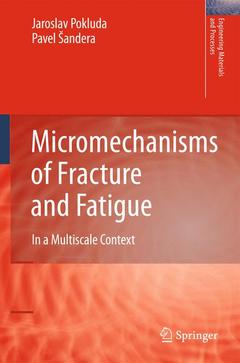Description
Micromechanisms of Fracture and Fatigue, 2010
In a Multi-scale Context
Engineering Materials and Processes Series
Language: English
Subject for Micromechanisms of Fracture and Fatigue:
Publication date: 07-2012
293 p. · 15.5x23.5 cm · Paperback
Publication date: 05-2010
293 p. · Hardback
Description
/li>Contents
/li>Biography
/li>Comment
/li>
Jaroslav Pokluda received his PhD in the Physics of Condensed Matter from the University of J. E. Purkyne, Brno, Czech Republic. He was with the Military Research Institute of Materials and Technology until 1985 and, since then, he has been with the Brno University of Technology as Associate Professor, Professor and Head of the Department of Materials Micromechanics and Applied Acoustics. His research interests include modelling micromechanisms of fracture and fatigue (metals and ceramics); atomistic computations of mechanical properties of crystals; quantitative fractography (metals and ceramics); and uniaxial and biaxial fatigue of materials (metals). He is an author or co-author of 3 textbooks and 92 papers in scientific journals. He has edited 4 special issues of scientific journals (Engineering Fracture Mechanics, Strength of Materials, Materials Science Forum) and is on the editorial board of the journals Strength of Materials and Physicochemical Mechanics of Materials. Since 1999 he has been the Czech representative in the European Structural Integrity Society (ESIS). He was a co-chair of 7 international conferences MSMF1-6, and ECF17. He received commemorative medals awarded by the Institute of Materials Research at the Slovak Academy of Sciences, Slovakia (2005) and Brno University of Technology, Czech Republic (2008).
Pavel Šandera received his PhD in the Physics of Condensed Matter from the Brno University of Technology, Czech Republic. Since 1978 he has been with the Brno University of Technology as Associate Professor and Professor (2006). His research interests include modelling micromechanisms of fracture and fatigue (metals and ceramics); atomistic computations of mechanical properties of crystals; stochastic geometry; and fatigue of materials (metals). He has published 41 papers in scientific journals and edited specials issues of Materials Science Forum and Engineering Failure Analysis. He is on the editorial board ofthe Eng
These books may interest you

Mechanics of Fatigue 74.82 €



